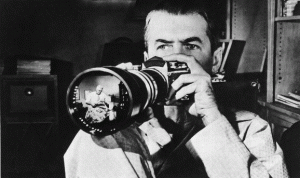
Tara Plath: FNewsMagazine
In “Ways of Seeing” John Berger explains that men and women have different types of social being. A man’s appearance shows their dominance through the amount of power they have. Women, on the other hand, show their appearance to display what can and what cannot be done to them. For example a man shows power through physical strength, or economical status. The more money he has, the more power he has. Meanwhile a woman is raised up from childhood to look good for the ‘man’, so she can be appreciated by him. Berger states “Men look at women. Women watch themselves being looked at. This determines not only most relations between men and women but also the relation of women to themselves. The surveyor of women in herself is male: the surveyed, female. Thus she turns herself into an object – and most particularly an object of vision: a sight.” (Berger p. 47) This shows that women are nothing more than a ‘spectacle.’
A gaze describes the act of looking; it’s how the audience views the object being presented. The male gaze is how men look at women and taking ownership of what they see. Laura Mulve describes in Visual Pleasure and Narrative Cinema that film audiences view the plot and characters from the heterosexual male perspective. So this is all shown through a patriarchic viewpoint. She states “in their tradition exhibitionist role women are simultaneously looked at and displayed, with their appearance coded for strong visual and erotic impact so that they can be said to connate to-be-looked-at-ness.” (Mulve p. 837) Here she explains that women are displayed as objects of sexual desire, which is transformed into exhibitionism.
The male gaze is dominant in popular culture because it satisfies this great pleasure we all get from looking at people. The pleasure we get from seeing people as objects is described as ‘scopophilia’ according to Mulve. We get a sense of power from being able to do this. In today’s Rap music videos women are displayed as objects. For example Make it Rain remix by Fat Joe music video shows money being thrown on women. Women are also wearing very sexually appealing clothes as the camera lingers on the curves of the female body.
The oppositional gaze, as described by Bell Hooks, challenges the authority of the spectator in order to give oneself agency or the permission to look. Specifically Hooks encourages black women not to accept stereotypical representations in film, but rather actively critique them. Historically, the male gaze posits the white male as the spectator; people of color are not permitted to be spectators especially when the object of the gaze is a white woman. Hooks states "Not only will I stare, I want my look to change reality." (p. 116) Here she challenges the male gaze's power to construct the mainstream reality and consciousness.
There are many cases where the oppositional gaze is present in society. Hooks talks about Spike Lee’s film Crooklyn. Crooklyn, as noted by Hooks, was criticized by white mainstream media for not having a plot however that was clearly not the case. In watching the film, the audience sees the story of a black family living in Brooklyn and the tragedy they experience when the mother becomes ill with cancer. The storyline, as hooks explains, is not of interest to critics and they therefore dismissed the film.
In contemporary society, media has definitely impacted everyone’s views on certain aspects on life. Women will still try to look pretty and men will admire them. The gazes are still present and will remain present until we evolve from this patriarchal society.
No comments:
Post a Comment
Note: Only a member of this blog may post a comment.